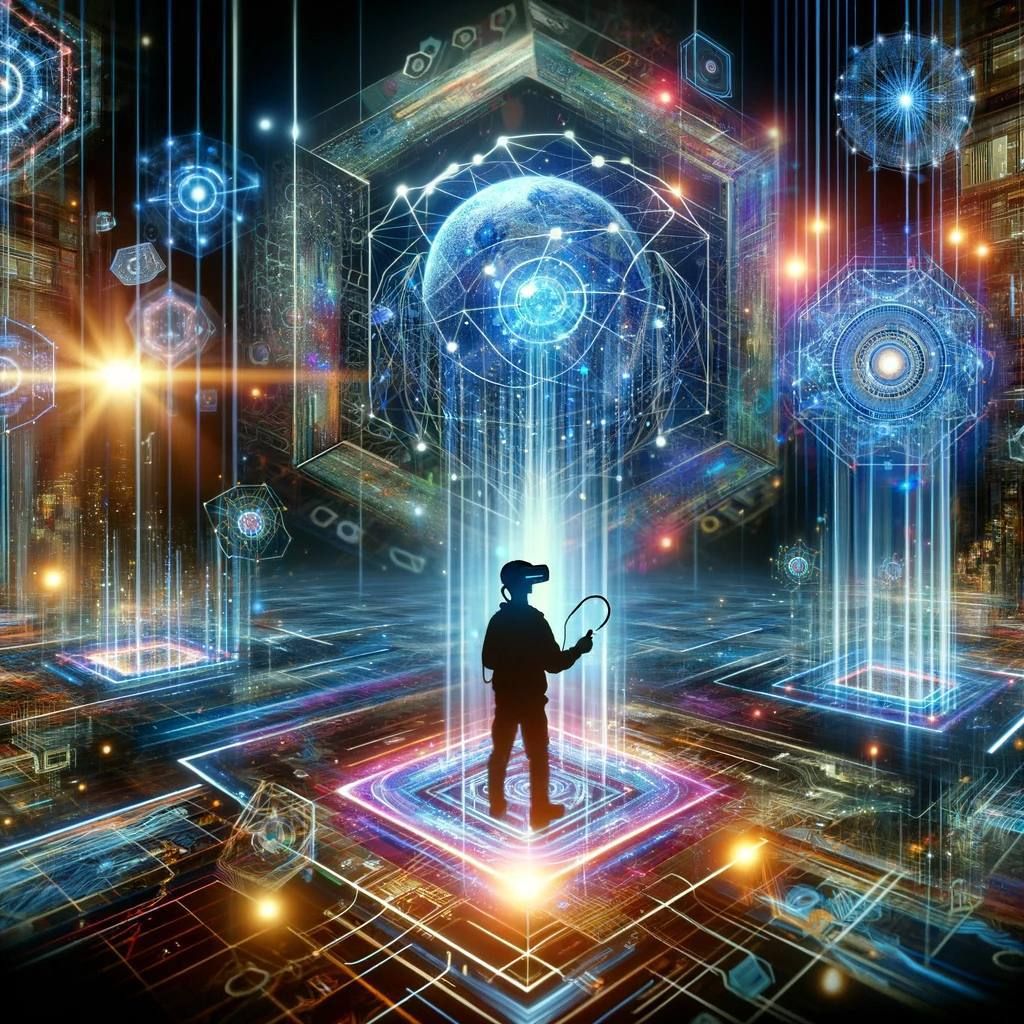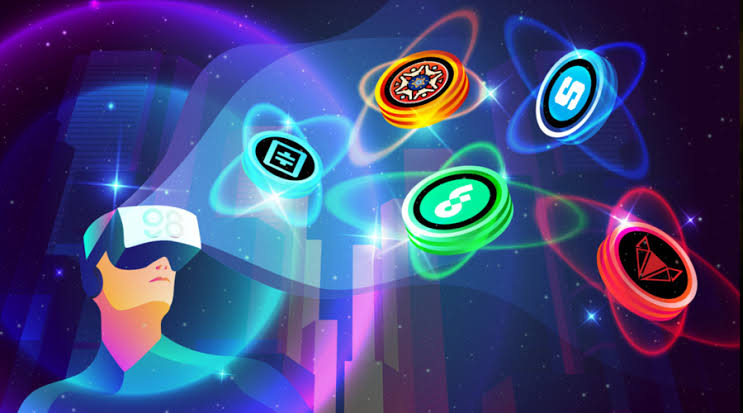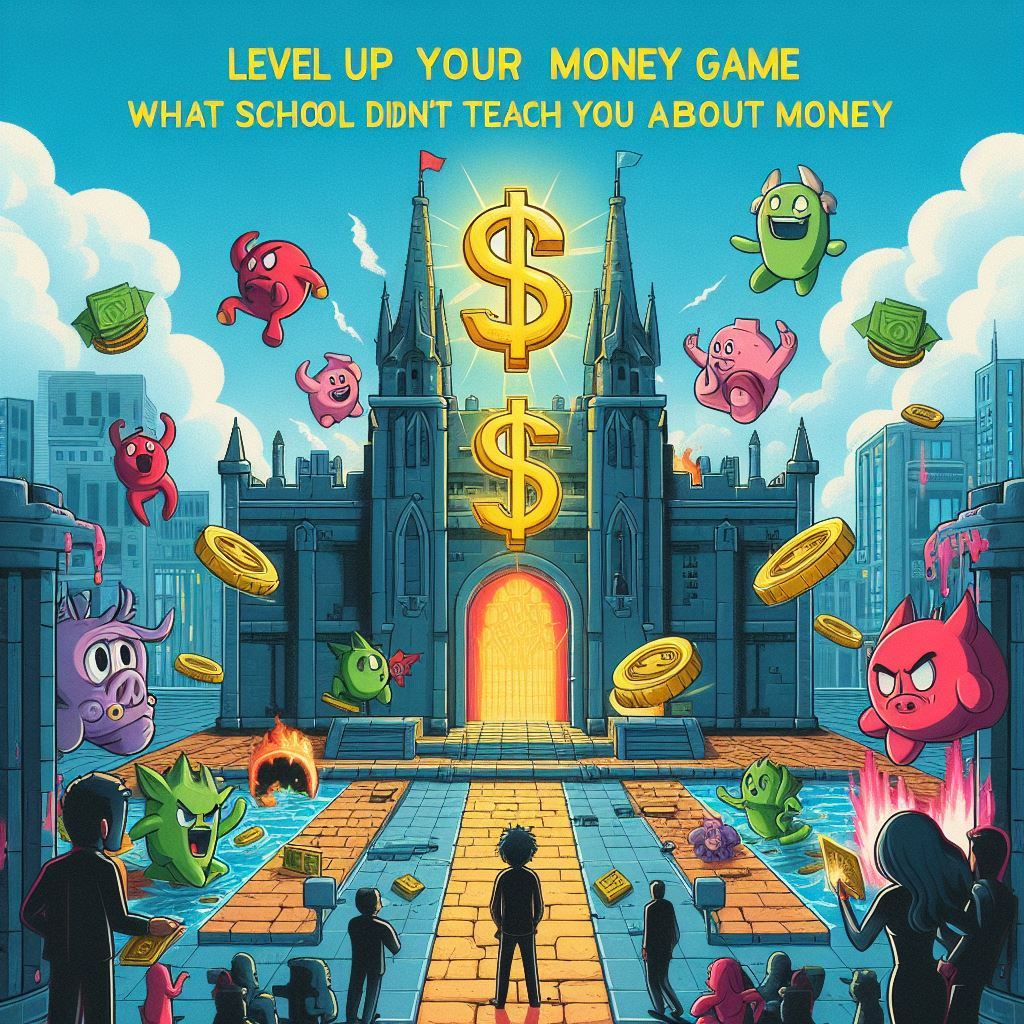The term “metaverse” has become a tech buzzword, but what exactly does it mean? Is it just a fancy word for online gaming, or is there something more transformative brewing?
Buckle up because we’re taking a deep dive into the metaverse, exploring its potential to revolutionize the way we live, work, and interact.

Demystifying the Metaverse
Imagine a seamless blend of our physical and digital worlds. A space where you can work, socialize, and even own virtual property, all accessible through a network of interconnected virtual experiences. That’s the core concept of the metaverse.
It’s not just about virtual reality (VR), although VR will likely play a significant role. The metaverse encompasses augmented reality (AR), mixed reality (MR), and the entire spectrum of online experiences.
Think of it like this: Today, the internet is a collection of websites. The metaverse aspires to be a collection of interconnected virtual worlds, each with its unique features and functionalities.
What Is a Metaverse?
Metaverse can be described as the inevitable evolution of internet advancement. But what exactly is this metaverse, and how will it transform our daily activities and business?
Imagine a virtual space where billions of people exist, work, shop, learn, and interact with one another from the comfort of their homes in the real world.
In this space, the smartphone screens we use today to connect to the internet to have access to information have become portals to a 3D virtual realm that’s palpable — like real life, only bigger and better. Digital facsimiles of ourselves, or avatars, move freely from one experience to another, taking our identities and our digital currencies along.
What we considered as hype yesterday does exist today, and it’s gradually affecting every aspect of human activities.
A Brief History of Metaverse
Metaverse is a vision of what many in the Information Technology space believe to be the next iteration of the internet – a single, shared, immersive, persistent, 3D virtual space where humans experience life in ways they could not in the physical world.
Some of the technologies that provide access to this virtual world, such as virtual reality (VR) headsets and augmented reality (AR) glasses, are evolving quickly; other critical components of the metaverse, such as adequate bandwidth or interoperability standards, are probably years off or might never materialize.
The concept is not new: The term metaverse was coined in 1992 by author Neal Stephenson in his sci-fi novel Snow Crash, and work on the technologies that underpin a virtual reality-based internet dates back decades
Key Characteristics of the Metaverse
The metaverse goes beyond the hype; it’s a network of interconnected virtual experiences with unique characteristics that set it apart from traditional online interactions. Here’s a closer look at some of these defining features:
- Persistence: Unlike online games that reset when you log out, the metaverse is persistent. This means the virtual world keeps evolving and exists independent of individual users. Imagine a virtual mall where stores can stay open 24/7, with customers coming and going and decorations changing based on real-world events.
- Interoperability: A core tenet of the metaverse is the ability to seamlessly move between different virtual worlds using the same avatar and virtual assets. Imagine attending a business meeting in a professional virtual environment, then transitioning to a fantasy world for an evening adventure, all with the same digital identity.
- Avatars and Virtual Identity: Your avatar will be your digital representation in the metaverse. It can be a realistic portrayal of yourself, a fantastical creation, or something in between. The ability to customize your avatar and express yourself digitally will be a significant aspect of metaverse interactions.
- User-Generated Content (UGC): The metaverse won’t be a static, pre-programmed environment. Users will be empowered to create their content and experiences. Imagine building your virtual art gallery, designing a fashion line for avatars, or even developing a mini-game within the metaverse.
- Economic Systems: Virtual economies are likely to flourish within the metaverse. Users might buy and sell virtual goods and services using cryptocurrencies or other digital tokens. This could create new opportunities for businesses and content creators, fostering a thriving digital marketplace.
- Real-World Integration: The metaverse isn’t meant to be a completely separate reality. Integration with the real world will be a key aspect. Imagine attending a virtual concert that has a synchronized real-world performance or using virtual tools to design and then 3D print a physical object.
- Sensory Immersion: While VR headsets will likely play a significant role, the metaverse isn’t limited to just vision. The ultimate goal is to create a multi-sensory experience that incorporates touch, smell, and even taste. Imagine feeling the texture of virtual clothing you’re trying on or smelling the aroma of a virtual bakery as you walk by.
- Spatial Awareness: The metaverse will be a three-dimensional space. Your avatar will occupy a physical location within the virtual world, and you’ll be able to interact with objects and other avatars in a natural, spatial way. Imagine attending a virtual lecture where you can move around the virtual classroom and interact with the virtual professor and other students.
These characteristics, when combined, paint a picture of a dynamic, evolving virtual world that blurs the lines between the physical and digital. The metaverse has the potential to become a new frontier for human connection, creativity, and commerce, but its development requires careful consideration of the ethical and social implications.
Beyond Virtual Reality

Virtual Reality (VR) has often been the poster child for the metaverse, with visions of strapping on headsets and entering fully immersive digital worlds. However, the metaverse is much more than just a fancy VR experience. Here’s why VR is just one piece of the puzzle:
A Spectrum of Realities:
The metaverse isn’t a single, monolithic world. It encompasses a spectrum of virtual experiences, with VR existing at the most immersive end. Imagine a sliding scale, with VR on one side completely blocking out your physical surroundings and Augmented Reality (AR) on the other, seamlessly overlaying digital elements onto the real world.
Mixed Reality (MR) sits somewhere in between, blending real and virtual elements to create interactive environments.
Beyond the Headset:
While VR headsets will undoubtedly play a role, the metaverse isn’t limited to them. Accessing the metaverse might involve using regular computers, smartphones, or even wearable tech like smart glasses.
The key is the ability to seamlessly connect and interact within these virtual spaces, regardless of the specific device used.
A Persistent Universe:
Unlike VR experiences that typically reset when you log out, the metaverse is persistent. Think of it like a giant, interconnected online world, similar to massively multiplayer online games (MMOs), but with a wider range of experiences and functionalities.
The changes you make to your avatar or virtual environment will be there when you return, fostering a sense of continuity and ownership.
Interoperability is Key:
A defining feature of the metaverse is the ability to move between different virtual worlds with the same avatar and potentially even your virtual assets.
Imagine attending a virtual business meeting on one platform and then teleporting to a virtual concert on another, all while maintaining your unique digital identity.
Not Just About Gaming:
While gaming will undoubtedly be a major component of the metaverse, it’s far from the only application. The metaverse has the potential to revolutionize how we work, learn, socialize, shop, and even consume entertainment.
Think virtual classrooms, collaborative workspaces in 3D environments, or attending virtual museums with friends from across the globe.
The metaverse is a complex and evolving concept, and VR represents just one way to interact with it. The true power lies in the interconnectedness, persistence, and ability to create and share user-generated content across a vast spectrum of virtual experiences.
Five Facts About Metaverse That You Should Know
The world may be virtual, but it’s highly realistic. You can do everything you’re used to in the real world: Buy clothes, build houses, make friends, build a career, make money, and a million other things.

The currency of Metaverse has real-world value. Unlike gamer points and levels, money in Metaverse isn’t exclusively dependent on the game itself. Bloomberg TV predicts the gaming market will grow to $800 billion by 2024, and many companies have taken that prediction seriously.
For example, Nike has developed virtual shoes for sale and American singer Ariana Grande has already earned over forty million on the sale of digital souvenirs.

The Land in the Metaverse is getting more and more expensive, and it looks like it still has far more growth to come. Just imagine that just a year ago, in December 2021, one of the most inexpensive pieces of land in Decentraland cost $14,000. The reason for the price increase is finite resources and increased demand.

Metaverse Space is not rubber-stamped. As we said, world space is finite, and soon what is already happening in the real world will happen – the prices of liquid properties will skyrocket. Do the math: Each parcel is 16 meters. Decentraland has an area of 1,440,000 square meters (144 hectares), comparable to the size of half of Moscow.

Metaverse is not only for gamers. It is a mistake to think that The Metaverse is something from the realm of game technology. The world is real and severe enough that some states will likely eventually open embassies in The Metaverse. Very soon, the embassy of the state of Barbados will launch.

Interested?
You’re in the right place; if you are a registered member of Meta Force Ecosystem already.
If you are not a Registered Member of Meta Force Ecosystem, comment below for me to me to put you through immediately to become a Registered Member of the biggest Crypto Project.
Stay tuned for more news and possibilities for The Metaverse. We’ll get you more info soon!

The Impact of Metaverse on The Global Economy
The metaverse holds immense potential to reshape the global economy, impacting various sectors and creating exciting new opportunities. Here’s a deeper dive into how the metaverse might disrupt and revolutionize various aspects of our economic landscape:
1. Rise of the Virtual Economy:
Imagine a thriving virtual marketplace where users can buy and sell virtual goods and services using cryptocurrencies or other digital tokens. This could encompass a vast array of digital products and experiences:
- Virtual Fashion: Avatars may require not just clothing but also accessories, hairstyles, and even cosmetics, creating a booming virtual fashion industry with its trends and brands.
- Digital Goods and Services: The possibilities extend far beyond fashion. Virtual furniture, vehicles, artwork, and even experiences like attending virtual concerts or sporting events could be bought and sold.
- Play-to-Earn Gaming: Games where players earn valuable in-game assets or cryptocurrencies could become a significant economic driver within the metaverse. This could lead to the rise of entirely new economies within games, with players potentially earning real-world value through their virtual activities.
- The Metaverse as a Workplace: Businesses could create virtual workspaces or hold meetings in the metaverse, leading to new business models for virtual office rentals, productivity tools designed specifically for the metaverse, and even virtual co-working spaces.
2. Transformation of E-commerce:
The metaverse could completely redefine the way we shop online. Here are some potential ways this transformation might play out:
- Virtual Showrooms: Trying on clothes in a virtual dressing room that personalizes your experience based on your avatar’s body type or visualizing furniture in your actual living space using AR overlays could become commonplace.
- Interactive Product Launches: Brands could host immersive virtual events to launch new products, allowing customers to interact with them in a novel way. Imagine a car manufacturer unveiling a new model with a virtual test drive experience or a makeup brand offering virtual consultations and tutorials for their latest products.
- Hyper-Personalized Shopping: The metaverse could enable highly personalized shopping experiences that go beyond what’s possible on traditional e-commerce websites. Virtual assistants powered by AI could recommend products based on your avatar and preferences, creating a seamless and engaging shopping journey.
3. The Metaverse Creator Economy:
The metaverse could unleash a wave of new creative opportunities, fostering a vibrant creator economy:
- Virtual Artists and Musicians: Artists and musicians could create and monetize their work entirely within the metaverse, hosting virtual concerts or galleries where fans can attend using their avatars and potentially purchase virtual merchandise or exclusive experiences.
- Virtual Architects and Designers: Avatars need homes (digital ones, at least)! Virtual architects and designers could create and sell virtual spaces and experiences, ranging from stunning mansions to fantastical landscapes.
- Content Creators: The metaverse will require a constant stream of engaging content to keep users engaged. There will be a growing demand for creators who can build games, experiences, social spaces, and even educational simulations within the virtual world. This opens up new opportunities for game developers, educators, and anyone with a creative vision and the ability to translate it into the virtual realm.
4. Redefining Remote Work:
The metaverse could revolutionize the way we work remotely, with benefits extending beyond just video conferencing:
- Enhanced Collaboration: Imagine attending meetings in a virtual conference room with colleagues from around the world, using 3D avatars and interactive whiteboards for real-time collaboration on projects. This could lead to more efficient brainstorming sessions and improved communication.
- Improved Training and Development: Employees could undergo immersive training simulations within the metaverse, fostering a more engaging and effective learning experience. Imagine a new sales trainee practicing their pitch in a virtual reality simulation that replicates a real-world sales call.
- Increased Productivity: Virtual workspaces could be designed to optimize workflow and minimize distractions, potentially leading to increased productivity. Imagine an environment where you can customize your workspace with the tools and information you need readily available, eliminating the need to switch between multiple applications or get sidetracked by browsing the internet.
5. The Road Ahead: Challenges and Considerations
While the economic potential is vast, there are challenges to consider before the metaverse can reach its full potential:
- Accessibility: VR/AR technology can be expensive, potentially creating a digital divide. Ensuring affordability and accessibility of the necessary equipment will be crucial for widespread adoption and to prevent the metaverse from becoming an exclusive playground for the wealthy.
- Regulation: The development of the metaverse raises new questions about intellectual property, digital ownership, and online behavior. Clear and effective regulations will be needed to protect users, ensure fair competition within the virtual economy, and prevent potential issues like fraud or abuse.
- Security: Protecting user data and financial transactions within the metaverse will be paramount. Robust security measures will be needed to prevent hacking, identity theft, and other forms of cybercrime.
Beyond the Economic Boom: A Look at the Broader Impact
The economic impact of the metaverse is undeniable, but its influence will likely extend far beyond just commerce. Here are some additional areas where the metaverse could have a significant impact:
- Education: Imagine attending a virtual lecture on the pyramids of Egypt and exploring a 3D recreation of their structure or participating in a virtual dissection of a frog in a biology class. The metaverse has the potential to revolutionize education by creating immersive and interactive learning experiences.
- Social Interaction: The metaverse could offer new ways to connect with friends and family, regardless of physical location. Virtual game nights, attending concerts with friends across the globe as avatars, or even exploring virtual museums together – the possibilities for social interaction are vast.
- Healthcare: The metaverse could be used for virtual therapy sessions, allowing patients to interact with therapists in a safe and controlled environment. Additionally, it could be used for medical training simulations, allowing doctors and nurses to practice procedures in a realistic virtual setting.
The metaverse is not just a futuristic fantasy; it’s a world under construction. While the economic potential is undeniably exciting, it’s important to approach its development with a balanced perspective. By acknowledging the challenges, fostering open dialogue, and prioritizing ethical considerations, we can help shape the metaverse into a force for good that benefits all.
The metaverse has the potential to revolutionize the way we live, work, and connect. Whether you’re a tech enthusiast, an entrepreneur, or simply someone curious about the future, it’s a development worth following closely.
The Role of NFTs in the Metaverse World

NFTs {Non-fungible tokens} play a big role in the usefulness and popularity of the metaverse. NFTs are a secure type of digital asset based on the same blockchain technology used by cryptocurrency. Instead of metaverse coins, an NFT can represent a piece of art, a song, or digital real estate by metaverse companies, which can be accessed using metaverse VR.
An NFT gives the owner a kind of digital deed or proof of ownership that can be bought or sold in the metaverse.
Metaverse company bills itself as the world’s first virtual real estate company. It acts as an agent to facilitate the purchase or rental of property or land in several metaverse virtual worlds, including Decentraland, Sandbox, Somnium, and Upland. Offerings include conference and commercial spaces, art galleries, family homes, and “hangout spots.”
While the metaverse has created opportunities for new companies, such as Metaverse Group, to offer digital goods, established brick-and-mortar companies are also jumping in.
For example, Nike acquired RTFKT, a startup that makes one-of-a-kind virtual sneakers and digital artifacts using NFTs, blockchain authentication, and augmented reality. On its website, RTFKT said it was “born on the metaverse, and this has defined its feel to this day.”
Prior to the acquisition, Nike filed seven trademark applications to help create and sell virtual sneakers and apparel. Nike and Roblox also partnered on “Nikeland,” a digital world where Nike fans can play games, connect and dress their avatars in virtual apparel.
“NFTs and blockchain lay the groundwork for digital ownership,” said Nick Donarski, co-founder of Ore System, an online community of gamers, content creators, and game developers. “Ownership of one’s real-world identity will carry over to the metaverse, and NFTs will be this vehicle.”
The Building Blocks of the Metaverse
While the metaverse itself may seem futuristic, the technologies that will power it are already being developed. Here’s a look at some of the key building blocks:
- Virtual Reality (VR): VR headsets create an immersive experience by completely blocking out your physical surroundings and replacing them with a computer-generated environment.
- Augmented Reality (AR): AR overlays digital information on the real world through headsets or smartphone cameras. Imagine seeing product information superimposed on a physical object you’re holding or attending a virtual meeting with holographic colleagues in your living room.
- Mixed Reality (MR): MR merges VR and AR, creating environments where real and virtual elements co-exist and interact. This could be used for anything from medical training simulations to overlaying virtual furniture in your actual living space.
- Blockchain: Blockchain technology, the foundation of cryptocurrencies, can be used to create secure and verifiable digital ownership within the metaverse. This could be essential for virtual assets like clothing for your avatar or virtual land.
- High-Speed Internet: The metaverse will require a robust and reliable internet infrastructure to support the high bandwidth demands of streaming VR/AR experiences and facilitating seamless interactions between users.
- Artificial Intelligence (AI): AI will play a crucial role in powering various aspects of the metaverse, such as personalizing experiences, driving virtual economies with intelligent agents, and moderating online interactions.
Metaverse Monetization

The metaverse presents a vast and largely untapped landscape for generating revenue. This digital frontier offers exciting opportunities for businesses and individuals alike. Here’s a deeper dive into some of the key ways users and businesses can potentially strike gold in the metaverse:
1. Virtual Goods and Services:
Digital Fashionistas: Imagine a thriving virtual fashion industry where users can purchase clothing, accessories, and even hairstyles for their avatars. This could be a major revenue stream for fashion brands and designers who create unique digital collections for the metaverse.
Luxury brands are already dipping their toes in these waters, with companies like Gucci offering virtual clothing and accessories that can be worn by avatars on platforms like Roblox.
The Great Decoration: The desire to personalize one’s virtual space extends beyond clothing. Users might pay for furniture, decorations, and other virtual assets to customize their avatars’ homes, offices, or even social spaces within the metaverse. This opens doors for businesses specializing in virtual interior design or furniture creation.
Specialized Services: Just like in the real world, there will likely be a demand for specialized services within the metaverse. Imagine virtual hair stylists or makeup artists who can personalize your avatar’s look, virtual personal trainers who can guide you through fitness routines in a virtual gym, or even virtual event planners who can help you organize a virtual party or conference.
2. Virtual Experiences and Events:
Front-Row Seats (Without Leaving Your Couch): The metaverse could revolutionize entertainment by offering immersive virtual concerts, sporting events, or theatrical performances. Users could pay for tickets to attend these events live with their avatars, potentially interacting with other attendees and even having exclusive virtual experiences.
Imagine attending a concert where you can explore the virtual backstage area or interact with other fans from around the world.
Educational Escapades: Educational institutions could create immersive virtual experiences to enhance learning. Imagine exploring a virtual museum exhibit on ancient Rome or participating in a historical reenactment within the metaverse. These experiences could be ticketed or offered as part of online educational programs.
Pay-Per-Play Adventures: Gaming within the metaverse could take on new dimensions. Imagine stand-alone, immersive virtual reality games that users pay to access and play. This could create a lucrative market for game developers who can create engaging and interactive virtual experiences.
3. The Power of Advertising:
Reaching Your Audience in a Whole New Way: Brands will have innovative ways to reach their target audience within the metaverse. Imagine virtual billboards in high-traffic areas, sponsored virtual events, or product placements within popular virtual games.
For example, a sportswear company could sponsor a virtual sporting event within the metaverse, with its logo displayed prominently on the virtual athletes’ uniforms.
Interactive and Immersive Ads: Advertising in the metaverse won’t be limited to static billboards. Imagine interactive ads where users can click on a virtual billboard to learn more about a product or even try it on virtually using their avatar.
4. Play-to-Earn Games:
Gamifying the Grind: Play-to-earn games, where players earn valuable digital assets or cryptocurrencies through gameplay, could become a significant aspect of the metaverse economy. This could incentivize users to spend more time within the metaverse, potentially leading to further opportunities for monetization through in-game purchases or subscriptions.
However, careful design is needed to avoid these games becoming overly greedy or exploitative.
5. The Metaverse as a Workplace:
Virtual Coworking Spaces: Companies could create virtual workspaces or co-working spaces within the metaverse. This could be a new revenue stream for companies specializing in virtual office design and management. Imagine renting a virtual office space for your remote team, complete with meeting rooms, collaboration tools, and even virtual watercooler areas for informal chats.
Virtual Conferencing on Steroids: The metaverse could transform how businesses conduct meetings and conferences.
Imagine attending a virtual meeting where you can interact with colleagues from around the world in a 3D virtual space, using whiteboards and other collaborative tools to work on projects together in real-time. This could lead to more productive and engaging meetings compared to traditional video conferencing.
These are just a few examples of the potential revenue streams within the metaverse. As the technology continues to evolve and user adoption grows, we can expect even more innovative ways to monetize this digital frontier.
However, it’s important to remember that the metaverse shouldn’t be solely focused on profit. Building a strong foundation based on user experience, ethical considerations, and a sense of community will be crucial for its long-term success.
The Ethical Considerations: Building a Responsible Metaverse
The development of the metaverse needs to be guided by ethical considerations. Here are some key areas that require careful attention:
- Data Privacy: Protecting user data and ensuring transparency about how it’s collected and used will be crucial.
- Digital Divide: Ensuring affordability and accessibility of VR/AR technology is essential to avoid creating a new class divide in the virtual world.
- Content Moderation: Effectively moderating user-generated content to prevent harassment, hate speech, and other harmful behavior will be a significant challenge.
- Addiction and Well-being: Strategies to promote healthy online habits and prevent addiction to the metaverse will be important.
Conclusion: Metaverse – The Dawn of a New Era
The metaverse is not a replacement for the real world; it’s an augmentation. It has the potential to revolutionize the way we interact, learn, work, and play. However, its development requires careful planning and collaboration to ensure it’s inclusive, safe, and beneficial for all.
As we stand at the precipice of this new era, it’s important to approach the metaverse with a sense of cautious optimism. By actively engaging in discussions, understanding the potential challenges, and advocating for responsible development, we can all play a role in shaping the future of this exciting new frontier.
Discover more from Digital Wealth Guru
Subscribe to get the latest posts sent to your email.







[…] an earning opportunity program on the Metaverse powered by Meta Force will be launched in the next few days. I believe it’s important to […]
[…] ForceCoin is the long-awaiting cryptocurrency of Meta Force on the Polygon network for transactions on the UniteVerse and Metaverse. […]